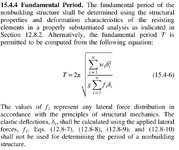Hello,
I have a question about section 15.4.4 in ASCE 7-16. I'm trying to use equation 15.4-6 to calculate the approximate period for a trussed tower. However, I don't understand the equation they give fully. It says fi represents any lateral force distribution, and then it says the elastic deflections need to be calculated using the applied lateral forces. My question is: do you apply all the lateral forces in 1 load case and use corresponding deflections, or do you apply 1 force at a time and use corresponding deflections?
I've tried both of these methods for the same force distribution and same trussed tower and I'm getting a different approximate period, so it looks like it does matter which one is chosen.
Appreciate it,
dh
I have a question about section 15.4.4 in ASCE 7-16. I'm trying to use equation 15.4-6 to calculate the approximate period for a trussed tower. However, I don't understand the equation they give fully. It says fi represents any lateral force distribution, and then it says the elastic deflections need to be calculated using the applied lateral forces. My question is: do you apply all the lateral forces in 1 load case and use corresponding deflections, or do you apply 1 force at a time and use corresponding deflections?
I've tried both of these methods for the same force distribution and same trussed tower and I'm getting a different approximate period, so it looks like it does matter which one is chosen.
Appreciate it,
dh

